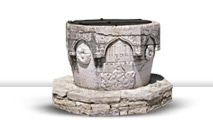
- Sečovlje Salt Pans - Dragonja River Valley
- Sv. Peter - Nova vas - Padna
- Pomjan - Nature Park: Karst Edge - Socerb
- Črni Kal - Osp - Kubed
- Momjan - Grožnjan - Pietrapelosa - Mirna
- Baštija - Kostanjica - Parenzana
- Oprtalj - Završje - Livade - Zrenj
- Istarske toplice - Motovun Forest - Višnjan
- Cave Mramornica - Feštini Kingdom - Cave Baredine
- Lim Bay - Kloštar - Kontija - Dvigrad
- Kanfanar - Bale - Palud - Vodnjan -Islands Brijuni - Fažana
- Svetvinčenat - Tinjan - Pićan - Gračišće
- Belaj - Šumber - Kožljak - Paz
- Čepićko Field - Kršan - Boljun Castle - Lupoglav
- Plomin - Kvarner Gulf - Brseč
- Nature park Učka - Mošćenice
Svetvinčenat - Tinjan - Pićan - Gračišće
Svetvinčenat
Set amidst large areas of oak forests, on a plateau surrounded by Barban, Žminj, Dvigrad, Bale and Vodnjan, the very beginnings of this town are connected with Benedictine monks from Ravenna, who in the 6th c. settled this area rich in wood.
The town has several names – Svetvinčenat, Savičenta, San Vincenti, all derived from the name of the patron saint and martyr St. Vincent and abbey of the same name around which a small town developed. Having cut down the forest, the diligent Benedictines cultivated the red soil, built houses and a church and so attracted the first inhabitants. That area was, as it still is today, without water courses, so the abbey was erected near a pond that was drained quite recently. The area also gained in importance as the border between three dioceses: Poreč, Pula and Pićan.
Svetvinčenat is often mentioned in documents: in the 10th c. as the property of the Poreč bishops, in the 12th c. the Pope confirms the Church of St. Vincent and in the beginning of the 14th c. it was mentioned in the Survey of Istrian Land Boundaries (Istarski razvod), a document drafted by a special land commission that covered the territory to define the property lines. Crosses on large stones marking the land division between counties are still visible today.
In its lengthy history the town continuously changed rulers and conditions for possession; centuries of Byzantine, Lombard and Frankish rule were followed by the rule of Poreč bishops, Patriarchs of Aquileia, Counts of Gorizia and Sergi family from Pula, later named Castropola. In the 15th c. the Morosini family completed the reconstruction of the Castle, and started to transform Svetvinčenat into a Renaissance town with square and cistern in the center, which apart from the castle, is surrounded by the Parish Church and loggia, as well as other public structures. Finally, as dowry it becomes the property of the Grimani family.
All sorts of banditry spoiled the relations between the town and surrounding villages, as did the Austrian rule which favored owners of large estates. During the period between the two World Wars, strong nationalist elements were felt.
The major attractions are the Morosini-Grimani Castle from the 13th c., Parish Church of the Annunciation of the Blessed Virgin Mary, square with cistern, Church of St. Vincent at the cemetery, painted with frescoes from the 12th c. and St. Catherine's Church from the 15th c. with frescoes from the beginning of the 18th c.
Print page Send to a friend

















